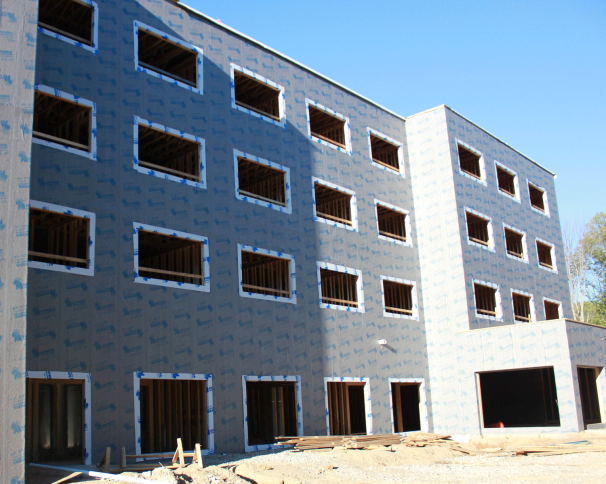An air barrier reduces air leakage through a building assembly (lowered air permeance). While many things can contribute towards being a barrier to air (building wrap, drywall, sheet plastic, rigid/batt insulation, caulks, tapes, mastics, etc) the discussion here is of specific membrane air barrier products. Many air barrier products also act as a vapor barrier (and some a water-resistive barrier as well). Air Barriers should not be confused with moisture-resistive barriers. Air barriers should also not be confused with vapor retarders which slow the movement of water vapor by diffusion. Lastly, air barriers should not be confused with weather barriers which are most commonly used as a building wrap to ‘resist’ air and moisture passage into the wall assembly/building. Air Barriers come in many different material types and the two primary application styles are:
-self-adhered membranes
-fluid-applied membranes
It is important to note than many manufacturers produce materials which serve more than one or all of the following purposes; vapor-retarder, moisture-resistant barrier, vapor-barrier. Air Barriers are most commonly used on building exteriors. Below are the most common air barrier product types:
Self-Adhered Membrane Air (& Vapor) Barrier

Is self-sticking sheet rolls commonly installed on building exteriors. Most products do not require a primer and can be installed on sheathing, aluminum, metal, drywall, cast-in-place concrete (7 day cure typically required), concrete block (stuck flush joints), brick (stuck flush joints), etc. For difficult to adhere surfaces spray applied or brush applied primer is usually available (some products however require primer on anything other than wood sheating). Material is typically lapped 2″ on sides and ends and has a ‘starting’ adhesive strip placed on the bottom of the roll. The material can be adhered by hand or with a rubber roller to promote consistent adhesion. Weather ranges for install are typically fairly wide at 0 – 150 degrees fahrenheit. Detail work around openings and penetrations requires great care to avoid compromising the complete sealed building envelope effect. Rough openings are often flashed with cut strips of membrane if other material is not specifically required. Common roll widths are 36″ and weigh 20-25 pounds but heavy duty versions can weigh more. Most membrane vapor barriers can resist UV exposure for up to 6 months.

Fluid-Applied Air Barrier

Is typically a single (polymer) or two-component (rubber); solvent based; spray or brush/roll applied; hot or cold-applied; polymer or rubber product which forms a strong, seamless, elastomeric membrane which resists vapor. The product commonly comes in 5 Gallon pails or 55 gallon drums and will usually cover 15-25 square feet per gallon (for smooth substrates) at an 80 mil (polymer) or 60 mil (rubber) application thickness. Most products can be installed down to 10 degrees fahrenheit but should not be installed on ‘green’ concrete (14 day cure minimum typical, some rubber products only 3 days). Most products can’t be installed onto polystyrene boards. When being installed on concrete block walls, all cracks/voids/irregularities/etc must typically be repaired with a specialty patching product a couple hours prior to fluid-applied barrier installation. Standard prep work to produce a clean, void free, protrusion free, hole free, consistent, dry substrate is required.

Some products (particularly rubber-based) may require ‘detailing’ openings, penetrations, and vulnerable areas which includes joint sealants, self-adhered flashings, or mastics to ensure maintenance of building envelope. When installing on exterior gypsum or fiberglass paneling, joints will typically require reinforced or mesh wallboard tape prior to installation of vapor barrier.

If the product is to be spray installed it must typically be passed through a heat exchanger to lower the viscosity before spraying. A ‘Big Rig’ (Hydraulic Airless) Sprayer (with a 0.035″ heavy duty switch tip) is typically recommended in terms of spray-application equipment to most effectively/efficiently apply the product. Roller application may require two coats (1-2 hours between coats) as 40mil is a typical thickness expectation when rolling. A ‘Wet Mil’ Gauge is often used to inspect the thickness during application.

Porous block walls may require more than one coat to achieve the needed thickness. The material is typically tack free in a couple hours. Temperature, humidity, airflow, sunlight, etc will effect drying time but 48 hours is typically recommended as a minimum before subsequent material application (except rubber product on which insulation boards can be placed when still slightly tacky). Xylene is commonly used to flush the sprayer unit of any excess material. 30-60 days is the typical max UV exposure time before degradation will occur. Rubber based products can be applied to wood sheathing, concrete block, concrete, exterior gypsum board, fiberglass sheathing, and brick veneer.